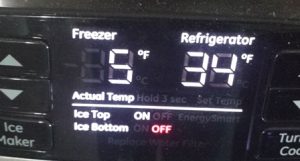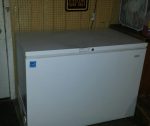 What is the ideal temperature I should keep my freezer & refrigerator at; is it really 0º & 40º? Doesn’t “freezing” always mean things are frozen? I turn my thermostat up during the summer & down during the winter to save electricity, hmm can I raise the temperature of my freezer likewise to save? Recently I ran across this tidbit “Raise the Freezer Temperature: As long as your freezer is below 32 degrees, your food will freeze.” Really?
What is the ideal temperature I should keep my freezer & refrigerator at; is it really 0º & 40º? Doesn’t “freezing” always mean things are frozen? I turn my thermostat up during the summer & down during the winter to save electricity, hmm can I raise the temperature of my freezer likewise to save? Recently I ran across this tidbit “Raise the Freezer Temperature: As long as your freezer is below 32 degrees, your food will freeze.” Really?
As many know, many like the FDA have always promote / mandate keeping your refrigerator at or below 40º and the freezer at 0º. Even legitimate “energy conservation / efficiency” sites like the Consumer Energy Center (run by CA.gov) states; “Check the temperature – a fridge that is 10 degrees colder than necessary can use 25 percent more energy. Refrigerators should be kept between 35 and 38 degrees, and freezers at 0 degrees Fahrenheit.” Sounds pretty simple right?
The case for raising or lowering temperatures:
I got to say I wish I could find the article I was reading a few weeks back, but it took a look at the possibility of changing the recommended temperatures, especially for freezers. In it they looked at the history of the current standards which were done based on studies from the 40’s or 60’s if memory serves me correctly. They believe that with todays newer technologies, quicker times to market / processing facility, and commercial flash freezing that we should relook at the standards and possibly raise them.
So the question is why was below 40 & o chosen in the first place. The first number for refrigerators was based on keeping bacteria growth to a minimum. That is one reason why you will have the numbers 40 & 140 drummed into your head if you have ever worked in the food industry. The freezing one delves more into science and looking at the best temperature to help preserve nutrients and slow / stop enzymes. As a reminder, enzymes essentially are what makes fruits and vegetables ripen and rot. In all the studies, zero degrees came out the winner.
Things to consider: The refrigerator
This is one item that we advocate that one keep the refrigerator around 34 degrees for a few reasons;
- The first as pointed out in Safety Sunday: To toss or keep the food the higher the temperature is the less of a buffer zone you have in case of power outage or over active kids
- Most people don’t turnover their food as much as a restaurant does (aka we might take a few weeks to go through one dozen eggs, while they go through dozens in a day) thus we want to make sure it is as good as it was when we put it away
- We don’t have refrigerated trucks delivering our food to us, so we need our refrigerator to cool it back down
- Newer refrigerators are better at keeping the whole chamber at the proper temperature while allowing items like fruits & vegetables to be stored at a slightly higher temperature / humidity level in special drawers so you shouldn’t have to worry about frozen items if you lower it down some.
Things to consider: The freezer
 One of the first items we must point out is that 32 degrees does not mean that something is frozen or will freeze. While a BTU is what is required to heat (or cool one pound of water) that only applies before it’s phase changes. To turn a liquid into a frozen state it must lose an additional 144 BTU’s before it is frozen.
One of the first items we must point out is that 32 degrees does not mean that something is frozen or will freeze. While a BTU is what is required to heat (or cool one pound of water) that only applies before it’s phase changes. To turn a liquid into a frozen state it must lose an additional 144 BTU’s before it is frozen.- The next item to point out is that saltwater freezes at a different temperature based on its salinity (aka sodium) level – most like NOAA simply state 28.4º
- The ice cream dilemma: Ever have a hard time scooping ice cream out of it’s container – well that is because of how cold your freezer is. If you would like softer scoopable ice cream consider bumping the temperature up to between 0 to 5º. As an FYI – Gellato is best between 0 to 18, Italian Ice between 10 to 18 with frozen custards coming in around 10 to 20.
- The downside to raising the temperature, per the studies for every 5º above zero the recommended storage time is cut in half for many products. Got a separate chest freezer, use it for long term storage while your regular one is great for using soon items
- Doing a lot of “preserving or storing” then a chest freezer brought down to it’s lowest setting will help freeze your food faster and the ice crystals formed will be smaller resulting in less damage. Once this is done consider bringing it back up to 0 to -10 at maximum.
- Ice crystals do form but are not generally visible (aka freezer burn)
- Freezer burn is not caused by the temperature, but rather moisture leaving the food and being exposed to the air. Consider using a “vacuum” type sealer to help eliminate / reduce this issue
Some quick final thoughts: In all reality, unless some new studies come out (and even maybe not especially if you do a lot of cooking at home), I would recommend one still keep there freezer at zero and the refrigerator at 34 degrees. While you might enjoy some cost savings if you run them a tad higher, one has to balance them against all the other factors. Now if you have separate freezer drawers or a standalone freezer, you might consider running one a little bit warmer for easier serving of ice creams if that is your thing. With that don’t always assume that the temperature displayed is accurate, consider investing in a Freezer / Refrigerator thermometer (just like you do for your oven) to ensure that the temperature is correct.
When I worked in a commercial kitchen – the refrigerator one stayed in a container of water & was inserted through a lid which helped us know what the refrigerator temperature was truly at, not just the air temp. The freezer one was inserted into the freezer unit itself which won’t work for normal ones, so hats off to Mark Luxton for the reminder & tip about inserting between two bags of vegetables or something similar.

Thank you so much for this article. I had the problem that my ice cream was too soft, almost melting! I did invest in thermometers for both of my refrigerators and I found the melty ice cream one (the brand new fridge) is on the coldest setting but registering a toasty 25 degrees. Not quite cold enough. I will try again placing it between two items, but I’m not sure I want to sacrifice bags of vegetables at this point! luckily the repair man is scheduled for Tuesday.
My pleasure & sorry to hear about the issues – here’s to them getting it fixed & not having pre-made milk shakes
In the case of my freebie it had such dense dust on the condenser that it looked at first like a piece of felt pack was in there. After preliminary cleaning left it on afor an hour or two and it was putting out cold air in the freezer. I would not see freezing temperatures coming at this temperature, but I guess you can’t expect much until it is leveled and cleaned and installed and given a week. Only then can I evaluate it. But it does work –or “works great” as they always say.
These are all crackpots. You can store at a higher freezing temperature but it will lose a lot of flavor. It is the temperature which counts. I don’t know if the state of water comes into it at all. It is all about storage, not vending ice cream. I have set my freezer much higher to lessen the load. Present fridge has seal problem. Replacement fridge looks okay, still in testing stage.l If you do any ice cream making with a canister, you really want zero for best results. And that is really an arctic blast. Not every fridge makes the cut.